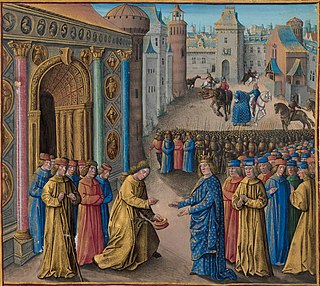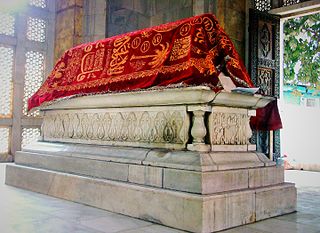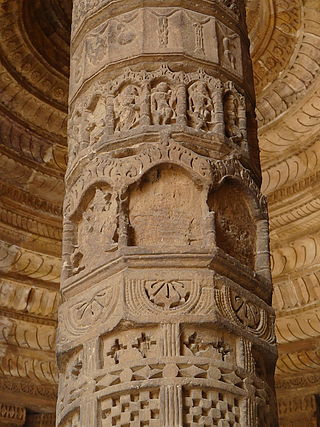Related Research Articles

Year 1148 (MCXLVIII) was a leap year starting on Thursday of the Julian calendar.

The Ghaznavid dynasty or the Ghaznavid Empire was a Persianate Muslim dynasty and empire of Turkic mamluk origin, ruling at its greatest extent from the Oxus to the Indus Valley from 977 to 1186. The dynasty was founded by Sabuktigin upon his succession to the rule of Ghazna after the death of his father-in-law, Alp Tigin, who was an ex-general of the Samanid Empire from Balkh.

Mu'izz ad-Din Muhammad ibn Sam, also known as Muhammad of Ghor or Muhammad Ghori, was a ruler from the Ghurid dynasty based in the Ghor region of what is today central Afghanistan who ruled from 1173 to 1206. Muhammad and his elder brother Ghiyath al-Din Muhammad ruled in a dyarchy until the latter's death in 1203. Ghiyath al-Din, the senior partner, governed the western Ghurid regions from his capital at Firozkoh whereas Muhammad extended Ghurid rule eastwards, laying the foundation of Islamic rule in South Asia, which lasted after him for nearly half a millennium under evolving Muslim dynasties.

Shams ud-Din Iltutmish was the third of the Mamluk kings who ruled the former Ghurid territories in northern India. He was the first Muslim sovereign to rule from Delhi, and is thus considered the effective founder of the Delhi Sultanate.

Qutb ud-Din Aibak, was a general of the Ghurid emperor Muhammad Ghori. He was in charge of the Ghurid territories in northern India, and after Muhammad Ghori's assassination in 1206, he established the Delhi Sultanate (1206–1526), and started the Mamluk dynasty, which would rule the Sultanate until 1290.

The Mamluk dynasty, also known as Slave dynasty, was a dynasty which ruled the Delhi Sultanate from 1206 to 1290. It was the first of five largely unrelated dynasties to rule the Delhi Sultanate until 1526. Before the establishment of the Mamluk dynasty, Qutb al-Din Aibak's tenure as a Ghurid dynasty administrator lasted from 1192 to 1206, a period during which he led forays into the Gangetic plain and established control over some of the new areas.
The Ghurid dynasty was a Persianate dynasty of presumably eastern Iranian Tajik origin, which ruled from the 8th-century in the region of Ghor, and became an Empire from 1175 to 1215. The Ghurids were centered in the hills of the Ghor region in the present-day central Afghanistan, where they initially started out as local chiefs. They gradually converted to Sunni Islam after the conquest of Ghor by the Ghaznavid ruler Mahmud of Ghazni in 1011. The Ghurids eventually overran the Ghaznavids when Muhammad of Ghor seized Lahore and expelled the Ghaznavids from their last stronghold.
Nasir-ud-Din Qabacha or Kaba-cha was the Muslim governor of Multan, appointed by the Ghurid ruler Muhammad Ghori in 1203.

Ghiyath al-Din Muhammad, also known as Ghiyath al-Din Ghori or Ghiyassuddin Ghori born, Muhammad, was the Sultan of the Ghurid dynasty. During the diarchy of Ghiyath and his younger brother Muhammad of Ghor, who governed the eastern realm of the Ghurid Empire, the Ghurids emerged as one of the greatest powers of the eastern Islamic world.

Bahram-Shah was Sultan of the Ghaznavid Empire from 25 February 1117 to 1152. Son of Mas'ud III and Gawhar Khatun, sister of Sanjar, sultan of the Great Seljuq Empire. During his entire reign, his empire was a tributary of the Great Seljuq Empire.
The Battle of Ghazni was fought in 1117 between the Seljuk forces supporting the claim of Bahram of Ghazna and the army of his brother the ruling Sultan Arslan-Shah of Ghazna.
The Battle of Ghazni was fought in 1151 between the Ghurid army of Ala al-Din Husayn and the army of the Ghaznavid Sultan Bahram-Shah of Ghazna. The Ghurid ruler defeated Bahram-Shah, captured the city, and destroyed it as revenge for the execution of his brother Quṭb ud-Dīn in 1149.
Ala al-Din Husayn was king of the Ghurid dynasty from 1149 to 1161. He was one of the greatest Ghurid kings, and it was during his reign that the Ghurid dynasty rose to prominence.
Sayf al-Din Suri was the king of the Ghurid dynasty from 1146 to 1149. He was the son and successor of Izz al-Din Husayn.
Baha al-Din Sam I, was the king of the Ghurid dynasty who reigned briefly in 1149. He was the brother and successor of Sayf al-Din Suri.
Fakhr al-Din Masud, was the first ruler of the Ghurid branch of Bamiyan, ruling from 1152 to 1163.

Harakeli Nataka is a Sanskrit drama written by the Chahamana (Chauhan) king Vigraharaja IV alias Visaladeva, who ruled from 1150 to 1164 CE. This drama is based on Kiratarjuniya of writer Bharavi.The play is also called Lalita Vigraharaja Nataka.

Vigraharāja IV, also known as and also Visaladev was a king from the Chahamana (Chauhan) dynasty in north-western India, and is generally considered as one of the greatest rulers of the dynasty. He turned the Chahamana kingdom into an empire by subduing the neighbouring kingdoms of Chaulukya, Naddula, and Tomara kingdoms. He also repulsed Muslim invasions, from the Ghaznavid ruler Bahram Shah and defeated Khusrau Shah in Vigraharaja IV's first war against the Muslims.
Khusrau Shah was the penultimate sultan of the Ghaznavid Dynasty from 1157 to 1160., and the eldest son of Bahram-Shah. During his short reign, he lost southeastern Afghanistan to Ala al-Din Husayn, Malik of Ghurid empire. He was succeeded by his son, Khusrau Malik.
The Siege of Lahore (1186) was part of the military expedition of Ghurids during which the Ghurid ruler Muhammad of Ghor annexed the principality of the Ghaznavids in Lahore after overthrowing the last Ghaznavid ruler Khusrau Malik.
References
- Jaques, Tony (2007). Dictionary of Battles and Sieges. Greenwood Publishing Group. ISBN 978-0-313-33538-9.